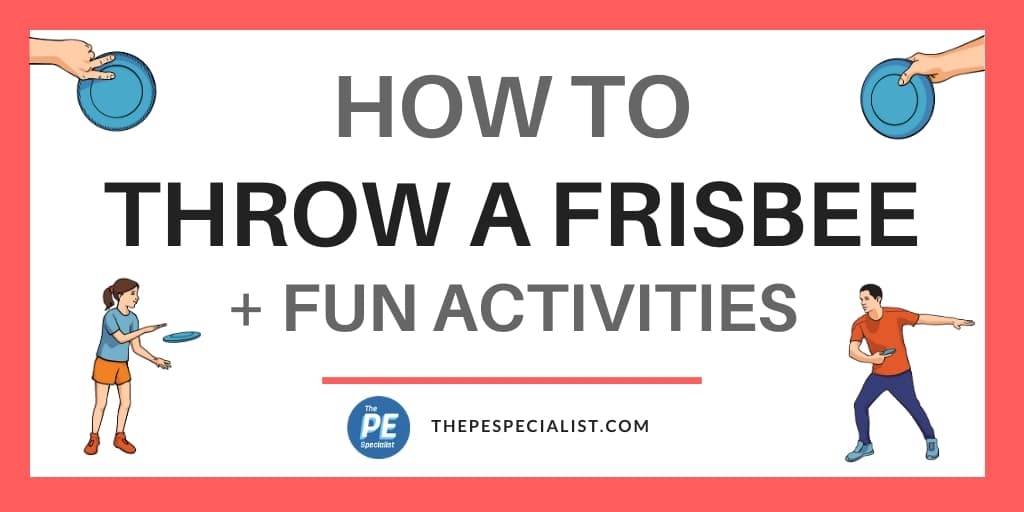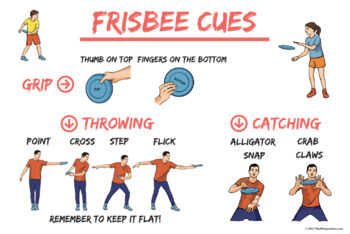Grip the Frisbee with your thumb on top and fingers underneath. Stand sideways to your target, swing your arm forward, and release with a wrist flick.
Mastering the art of throwing a Frisbee can be a rewarding skill for both fun and fitness, appealing to beginners eager to delve into this timeless activity. With straightforward mechanics and the opportunity for outdoor social interaction, Frisbee throwing encompasses more than just a casual play in the park.
It’s the bedrock of ultimate frisbee and disc golf, two sports that have surged in popularity. This introduction equips novices with the fundamentals of disc dynamics, offering a simple breakdown on how to embark on their Frisbee-flinging journey. Embracing this skill can lead to hours of enjoyment, improved coordination, and perhaps the start of a new athletic hobby.
Contents
Getting Ready To Throw
Before mastering the art of throwing a Frisbee, some groundwork is crucial. Prepare for smooth sailing across the field or beach with these beginner-friendly tips. Start by selecting a suitable Frisbee, finding the proper stance, and mastering wrist movement.
Choosing the Right FrisbeeChoosing The Right Frisbee
A good Frisbee match hinges on the disc. Consider the weight and size for your needs. Beginners fare well with lightweight and medium-sized Frisbees. Here’s a simple guide:
- Lightweight Frisbees: Easier to handle and throw.
- Medium-sized Frisbees: Offer a balanced flight and grip.
- Heavier discs: Suited for windy conditions but harder to manage.
Basic Stance And Grip
Your stance and grip lay the foundation for a successful throw. Proper form is simple:
- Stand with your feet shoulder-width apart.
- Turn your body slightly – use your shoulder to aim.
- Hold the Frisbee with a firm grip.
- Index finger along the rim, thumb on top.
- Other fingers rest beneath the disc, in support.
The Importance Of Wrist Movement
The wrist’s snap is the secret to a soaring Frisbee. A masterful flick generates spin, stabilizing its flight. Train your wrist to move like this:
- Hold your arm steady – the wrist does the work.
- Practice flicking the wrist separately from the arm throw.
- Snap quickly and firmly for the best spin.

Credit: www.thepespecialist.com
The Backhand Throw
Throwing a frisbee can be much fun, especially the backhand throw. Mastering this throw is vital for any player.
Step-by-step Guide
Perfecting the backhand throw involves these key steps:
- Stance: Stand with feet shoulder-width apart.
- Grip: Hold the disc with four fingers underneath and thumb on top.
- Arm Position: Keep your throwing arm straight and pulled back.
- Body Movement: Twist your torso while swinging your arm forward.
- Release: Let go of the disc when your hand points towards your target.
- Follow Through: Continue the motion of your arm even after releasing the disc.
Common Mistakes
Avoid these frequent errors to improve quickly:
- Loose Grip: A grip that’s too weak can spoil your throw.
- Bad Timing: Releasing the disc too early or late changes its path.
- Wrong Stance: A shaky stance reduces accuracy and power.
- Overpowering: Too much force can send the disc off course.
Tips For More Spin And Power
For added spin and power:
- Wrist Snap: Flick your wrist hard when releasing the disc.
- Use Your Legs: Push off the ground to gain extra momentum.
- Smooth Motion: Ensure your movements are fluid, not jerky.
- Practice: The more you throw, the stronger and more controlled your spins will become.
Mastering The Forehand Flick
Throwing a Frisbee is an art, and the forehand flick is a fundamental stroke for newcomers. This powerful throw travels fast and far when done correctly. Beginners can quickly learn and enhance their game with a few tips. Mastering the forehand flick takes practice, but starts with your grip, arm movement, and the disc release.
Understanding the GripUnderstanding The Grip
Hold the Frisbee correctly to control its flight. Beginners tend to underestimate the importance of the grip.
- Place your index finger along the rim.
- Rest your thumb on top for pressure.
- The remaining fingers curl underneath the disc.
Elbow And Wrist Positioning
The forehand flick requires precise elbow and wrist motions. Keep your elbow tight and the wrist flexible.
- Start with your elbow close to your body.
- Flexivity in the wrist is key for spin.
- Use a spring-like wrist snap as you release.
Controlling The Release
The magic of the forehand flick lies in the release. Proper release dictates the disc’s stability.
| Step | Action |
|---|---|
| 1 | Align the disc with your forearm. |
| 2 | Keep the disc level. |
| 3 | Release it in a smooth, swift motion. |
Throwing Techniques Variations
Welcome to the exciting world of frisbee throwing! Whether you want to play catch at the park or join a game of ultimate frisbee, mastering the basics is essential. Let’s explore varied throwing techniques that will turn you from a beginner to a confident thrower in no time.
Learning The Overhead Throw
Overhead throws are a fun way to surprise your opponent. You’ll need to stand sideways to your target for this throw. Lift your hand above your head, holding the frisbee vertically.
Use a swift motion to snap it forward while releasing the frisbee. This throw is great for dodging defenders.
Behind The Back Techniques
For a showy move, try the behind the back throw. Face your body away from your target. Reach your throwing hand behind and across your back. Give the frisbee a smooth flick with your wrist to send it flying.
This throw is tricky, so practice is key.
Adjusting Throws For Distance And Effect
| Technique | Distance | Effect |
|---|---|---|
| Backhand Throw | Short to Medium | Steady & Controlled |
| Forehand Flick | Medium to Long | Fast & Curving |
| Hammer Throw | Medium | Overhead Arc |
For longer distances, use a full arm extension and a strong wrist flick. For more precise effects, adjust the angle of release and the spin you put on the frisbee.
Experiment with grip pressure, release timing, and body positioning to find what works best for you.
Practice Drills For Improvement
Mastering the art of throwing a Frisbee takes practice and the right techniques. For beginners looking to improve their game, here are some essential practice drills. These drills help develop accuracy, power, and adaptability in various playing conditions. Incorporate these exercises into your practice routine and watch your Frisbee skills soar!
Starting With Short Throws
Begin with the basics and perfect your short-range throws. This drill focuses on form and spin, which are crucial for longer throws later on.
- Stand 10-15 feet apart from a partner.
- Use a consistent grip and smooth wrist action.
- Aim to keep the Frisbee level and steady.
- Practice this 20 times before increasing the distance.
Target Practice
Sharpen your accuracy with target practice. It challenges you to hit a specific spot, improving your throwing precision.
- Place a target like a cone or hoop at varying distances.
- Stand behind a marked line and aim to throw at the target.
- Keep track of your hits and misses and strive for improvement.
Throwing In Different Conditions
Playing in various weather conditions can greatly affect your throws. Adapt to wind and other elements with this drill.
- Try throwing on a windy day to understand how the Frisbee reacts.
- Experiment with different angles and speeds to find the best approach.
- Switch up locations, from open fields to wooded areas, for diverse challenges.

Credit: www.theglobeandmail.com
Troubleshooting Common Issues
Mastering the art of throwing a Frisbee takes time and practice. Beginners might face a few common issues that can lead to frustration and hinder their progress. Fear not! Identifying and correcting these problems is key to improving your Frisbee game. Let’s troubleshoot some of the typical issues you might encounter as a newbie to this fun and engaging sport.
Dealing With Inaccuracy
If you find your throws are often missing their mark, don’t worry. This is a common problem for beginners. Assess your stance, grip, and release. Make sure your feet are shoulder-width apart and your grip is firm but not too tight. Additionally, focus on releasing the Frisbee at the correct moment. The disc should leave your hand when your arm is pointing towards the target. Practice these adjustments to enhance precision.
Adjusting For Wind
Throwing a Frisbee in windy conditions can be tricky. The wind can take your disc in unexpected directions. Pay attention to the wind’s direction and adjust your aim accordingly. A good rule is to throw into the wind for shorter, more controlled throws, and with the wind for longer distances. Experiment with different angles and throwing strengths to see what works best for you.
Understanding Disc Flight Patterns
Every Frisbee has a unique flight pattern, referred to as its stability. A disc will turn (fade to the right for right-handers) or fade (curve left) during flight. Get to know your disc by throwing it at different speeds and angles. Observe how it behaves and use this knowledge to predict its path. This understanding will prove invaluable for making accurate throws in various situations.
- Stable discs fly straight and are great for beginners.
- Understable discs turn right and work well for long, curving shots.
- Overstable discs have a strong fade to the left, suitable for windy conditions or sharp curves.

Credit: www.teacherspayteachers.com
Frequently Asked Questions For How To Throw A Frisbee For Beginners
How Do You Throw A Basic Frisbee?
Stand with feet shoulder-width apart, gripping the Frisbee with your thumb on top. Bend your elbow, positioning the disc beside you. Snap your wrist firmly while extending your arm towards your target. Release the disc with a smooth motion at chest height for a level flight path.
How Do You Teach A Child To Throw A Frisbee?
Start by showing the child how to grip the Frisbee with their thumb on top and fingers underneath. Teach them the basic backhand throw, with the arm swinging across the body. Demonstrate how to snap the wrist upon release to give the Frisbee spin.
Practice short, gentle tosses before attempting longer throws. Encourage a straight arm follow-through towards the target.
What Are The 3 Basic Skills Of Frisbee?
The three basic skills of Frisbee are throwing, catching, and passing effectively.
What Are The 3 Types Of Frisbee Throws?
The three main types of Frisbee throws are the backhand, forehand, and hammer throw.
Conclusion
Mastering the art of Frisbee throwing opens up endless fun, whether in the park or at the beach. Remember to keep your movements fluid, your grip firm yet comfortable, and your wrist snappy. Practice makes perfect, so grab a disc, find some space, and let it fly! Embrace the simple joy of a well-thrown Frisbee and the sense of accomplishment that comes with improving your technique.
Ready to impress with your new skills? Go out and enjoy the game!